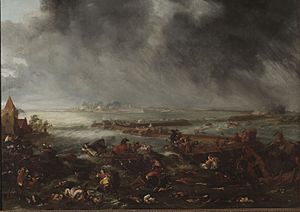Siege of Groningen (1672) facts for kids
Quick facts for kids Siege of Groningen |
|||||||
|---|---|---|---|---|---|---|---|
| Part of Franco-Dutch War | |||||||
 The siege of Groningen in 1672, by Dirk Maas |
|||||||
|
|||||||
| Belligerents | |||||||
| Commanders and leaders | |||||||
| Strength | |||||||
| 24,000 | unknown | ||||||
| Casualties and losses | |||||||
| 12,000 killed | unknown | ||||||
The Siege of Groningen was an important battle that happened in 1672. This year was known as the "Rampjaar" (Disaster Year) in the Dutch Republic. Many countries attacked the Netherlands at once. The Siege of Groningen was part of a bigger conflict called the Franco-Dutch War.
This battle was a big win for the Dutch. It stopped the Bishop of Münster from moving further into the Netherlands. The Münster army was so weakened by this defeat. Because of this, the Dutch army was able to take back much of the land Münster had captured earlier. Today, the city of Groningen still celebrates this victory. It is a local holiday on August 28th every year.
Contents
What Was the Franco-Dutch War?
The Franco-Dutch War (1672–1678) was a major conflict in Europe. It involved France, led by King Louis XIV, and its allies. They fought against the Dutch Republic and its allies. The war started because France wanted to expand its territory. It also wanted to weaken the Dutch Republic. The Dutch Republic was a powerful trading nation.
The "Rampjaar"
The year 1672 was very difficult for the Dutch. It is called the "Rampjaar," meaning "Disaster Year." France, England, and the Bishopric of Münster all attacked the Dutch Republic. The French army quickly moved through the country. The English navy attacked from the sea. The Bishop of Münster attacked from the east. The Dutch faced threats from all sides.
Who Was the Bishop of Münster?
The Bishop of Münster was Bernhard von Galen. He was a powerful religious leader. He also ruled a territory called the Prince-Bishopric of Münster. This area is now part of Germany. Bernhard von Galen was known for his military skills. He was sometimes called "Bomben Berend" (Bombardment Bernard). This nickname came from his love for using cannons in battles. He wanted to expand his territory. He saw the "Rampjaar" as a chance to attack the Dutch Republic.
Why Was Groningen Important?
Groningen was a very important city. It was a strong fortress in the northern Netherlands. It controlled key roads and trade routes. If the Bishop of Münster could capture Groningen, it would open the way. He could then push deeper into the Dutch Republic. Capturing Groningen would also give him a strong base. It would be a major victory for his forces.
The Siege Begins
The Bishop of Münster's army was large. It had about 24,000 soldiers. They arrived at Groningen in July 1672. The city was defended by Carl von Rabenhaupt. He was a skilled Dutch commander. He had fewer soldiers than the attacking army. But the people of Groningen were ready to fight. They helped prepare the city's defenses.
Daily Life During the Siege
Life inside Groningen was tough during the siege. The Münster army constantly fired cannons at the city. They tried to break down the walls. People had to hide in cellars for safety. Food and supplies became scarce. Despite the danger, the people worked together. They helped repair damaged walls. They also helped care for the wounded.
The Dutch Defense
Carl von Rabenhaupt used smart tactics. He made sure the city's defenses were strong. He used the city's canals and waterways to his advantage. The Dutch defenders fought bravely. They fired back at the attackers. They also made quick attacks outside the city walls. These attacks kept the Münster army busy. The defenders refused to give up.
The Siege Ends
The siege lasted for over a month. The Münster army suffered heavy losses. Many soldiers were killed or wounded. They also faced problems with sickness. Their supplies were running low. The Dutch defense was too strong. On August 17, 1672, the Bishop of Münster gave up. His army retreated from Groningen. It was a clear victory for the Dutch.
The Aftermath
The victory at Groningen was a turning point. It boosted the morale of the Dutch. It also weakened the Bishop of Münster's army. After this defeat, the Dutch army went on the attack. They successfully took back many areas. These areas had been captured by Münster earlier. The victory helped save the northern Netherlands. It showed that the Dutch could fight back.
Celebration Day
Every year, on August 28th, Groningen celebrates its victory. This day is called "Bommen Berend" (Bombardment Bernard). It is a local holiday. People remember the brave defense of their city. There are often parades and festivities. It is a day to celebrate the city's history and resilience.

